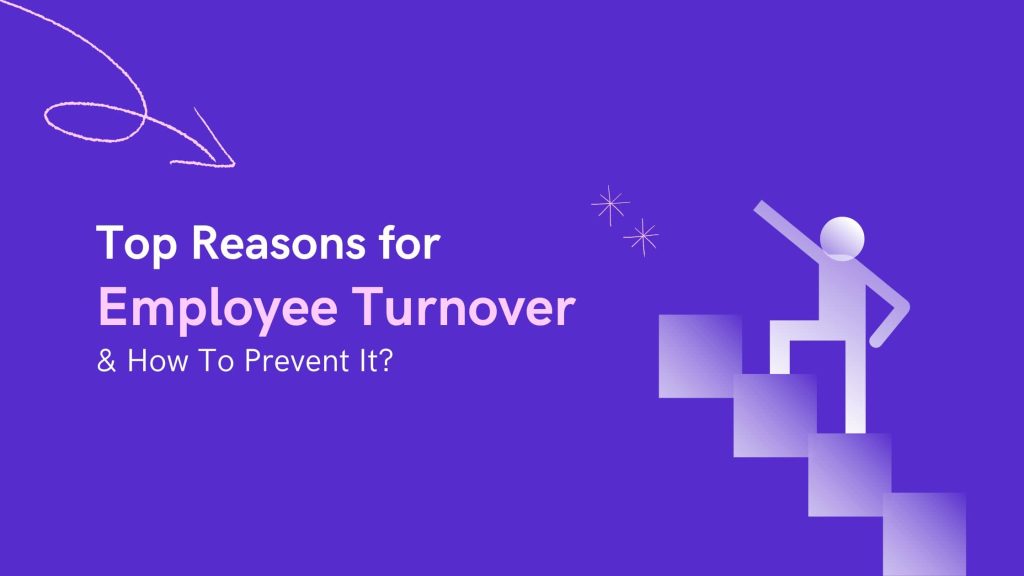Top Reasons for Employee Turnover & How To Prevent It?
Studies say bosses prefer people who are already employed, especially if they can take them from other companies. That’s why companies always try hard to keep their employees. Losing a good worker is a big problem and it costs a lot to find and train someone new. Also, when someone who’s been working for a long time leaves, they take a lot of important knowledge about the company and its customers with them.
So, it’s smart for companies to spend a little to keep their good workers. It helps in many ways, both with clear benefits and with things that are harder to measure.
Why Is Employee Turnover Bad?
When employees leave their jobs, it can cause problems for both the company and the people who work there. Here’s why:
- Disruption: When someone leaves their job, it can disrupt the work that needs to be done. Other employees might have to take on extra tasks until a replacement is found, which can make things harder for everyone.
- cost of employee turnover: Finding and training a new employee costs money. The company has to spend time and resources on recruiting, interviewing, and hiring someone new. Then, they have to train the new person, which takes even more time and money.
- Lost Knowledge: Employees who have been with the company for a long time often know a lot about how things work. When they leave, they take that knowledge with them. This can be a big loss for the company, especially if the employee had important relationships with customers or knew how to solve difficult problems.
- Low Morale: When people see their coworkers leaving, it can make them feel like something is wrong with the company. This can lead to low morale and make it harder for the remaining employees to stay motivated.
Overall, employee turnover can be a big problem for companies. It can cost a lot of money, disrupt the work that needs to be done, and lead to low morale among the remaining employees. That’s why it’s important for companies to try to keep their employees happy and motivated, so they’re less likely to leave.
What Is a Good Employee Turnover Rate?
The employee turnover rate is how many employees leave a company and need to be replaced. A good turnover rate means that not too many people are leaving their jobs. Here’s what to think about when looking at turnover rates:
- Low is Better: Generally, a lower turnover rate is better because it means fewer people are leaving. This can be a sign that employees are happy and satisfied with their jobs.
- Industry Standards: Every industry is different, so what’s considered a good turnover rate can vary. Some industries might have higher turnover rates because of the nature of the work or other factors.
- Retention Efforts: Companies can work to keep their employees happy and motivated to reduce turnover. This might include things like offering competitive salaries, providing opportunities for growth and advancement, and creating a positive work environment.
- Monitoring Trends: It’s important for companies to keep an eye on turnover rates over time to see if there are any patterns or trends. If turnover rates start to increase, it could be a sign that something needs to change.
In simple terms, a good employee turnover rate means that not too many people are leaving their jobs, and employees are happy and satisfied with their work.
What are the Causes of High Employee Turnover?
When a lot of employees leave their jobs, it’s called high turnover. Here are some reasons why this might happen:
- Unhappy Employees: If employees aren’t happy with their jobs, they might leave. This could be because they don’t feel appreciated, they don’t like their coworkers, or they don’t have opportunities to grow and learn.
- Bad Management: Sometimes, employees leave because they don’t like their boss or the way they’re being treated. If managers aren’t good at their jobs or don’t communicate well with their employees, it can lead to high turnover.
- Low Pay: If employees feel like they’re not being paid enough for the work they do, they might look for other jobs that pay better.
- No Opportunities: Employees want to feel like they have opportunities to grow and advance in their careers. If they feel like there’s no room for growth at their current job, they might leave to find better opportunities elsewhere.
- Bad Work Environment: A toxic work environment can make employees unhappy and cause them to leave. This could be because of things like harassment, bullying, or discrimination.
Overall, high employee turnover can be caused by a combination of factors, including unhappy employees, bad management, low pay, lack of opportunities, and a bad work environment.
How does employee turnover hurt your organization?
When workers leave your company, it can cause problems in many areas:
First, it costs money to find and train new workers. If lots of people leave, you have to spend even more money on finding and teaching new ones.
Second, when someone leaves, it can mess up the work that needs to be done. This can make things take longer and not work as well.
Also, when workers leave, they take with them important things they know about how the company works and who the customers are. It’s hard to replace this knowledge.
When people see their coworkers leaving, it can make them feel unhappy and not want to work as hard.
Lastly, if lots of people leave your company, it can make your company look bad. People might not want to work for you or buy from you if they think your company isn’t stable.
So, when workers leave your company, it can cost you money, make your work harder, lose important knowledge, make workers unhappy, and make your company look bad. It’s important to figure out why workers are leaving and try to fix the problems.
Top reasons for Employee Turnover & How to Reduce Them
Employee turnover can be a significant challenge for organizations, leading to increased costs, disrupted workflows, and decreased morale among remaining employees. Understanding the root causes of turnover is crucial for implementing effective strategies to reduce it. Here are ten top reasons for employee turnover and actionable steps to address them:
- Lack of Employee Purpose:
Employees want to feel like their work is meaningful and contributes to a larger purpose. To reduce turnover related to lack of purpose, organizations should clearly communicate their mission, values, and the impact of employees’ contributions on achieving company goals. Providing opportunities for employees to connect with the company’s mission can increase engagement and satisfaction. - Poor Compensation:
Employees may leave if they feel they are not fairly compensated for their work. To address this, organizations should regularly review and adjust salary and benefits packages to remain competitive in the market. Additionally, offering performance-based incentives or rewards can motivate employees and demonstrate appreciation for their contributions. - Being Overworked:
Overloaded workloads can lead to burnout and dissatisfaction among employees. Organizations should prioritize workload management and ensure employees have reasonable expectations for their responsibilities. Providing resources and support to help employees manage their workload effectively can prevent burnout and turnover. - Bad Managers:
Poor leadership and management practices can drive employees away. Organizations should invest in training and development programs for managers to improve communication, coaching, and conflict resolution skills. Building strong relationships between managers and employees based on trust, respect, and support can enhance employee satisfaction and retention. - Little to No Feedback or Recognition:
Employees crave feedback and recognition for their contributions. Implementing regular performance evaluations and acknowledgment programs can help employees understand their strengths and areas for improvement. Recognizing and celebrating achievements, both big and small, can boost morale and motivation. - Poor Work/Life Balance:
Maintaining a healthy work/life balance is essential for employee well-being and retention. Organizations should encourage flexible work arrangements, promote time-off policies, and discourage excessive overtime. Creating a culture that values work/life balance and supports employees’ personal needs can improve job satisfaction and loyalty. - Boredom:
Monotonous or unchallenging work can lead to disengagement and turnover. Offering opportunities for skill development, job rotation, and meaningful projects can keep employees engaged and stimulated. Providing avenues for creativity and innovation can reignite passion and interest in their work. - No Opportunity for Growth or Development:
Employees want opportunities to learn, grow, and advance in their careers. Organizations should invest in training programs, mentorship opportunities, and career development plans to help employees reach their full potential. Providing clear pathways for advancement and promoting from within can increase loyalty and retention. - Bad Hiring Procedures:
Hiring the wrong candidates can lead to turnover and dissatisfaction among employees. Organizations should improve their recruitment and selection processes to ensure they are hiring candidates who are a good fit for the role and the company culture. Conducting thorough interviews, background checks, and reference checks can help identify the best candidates for the job. - Toxic or Negative Culture:
A toxic work environment can drive employees away and damage morale. Organizations should foster a positive and inclusive culture that values diversity, respect, and collaboration. Addressing issues such as harassment, discrimination, and bullying promptly and transparently can create a safe and supportive workplace where employees feel valued and respected.
In summary, addressing the root causes of employee turnover requires a multifaceted approach that involves addressing issues related to purpose, compensation, workload, leadership, feedback, work/life balance, engagement, growth opportunities, hiring processes, and organizational culture. By implementing strategies to reduce turnover, organizations can improve employee retention, morale, and overall organizational success.
Monitoring Employee Turnover with HR Software
Keeping track of employees leaving their jobs can be made easier with HR software. This special computer program helps companies keep a record of who leaves and why they left.
With HR software, businesses can see patterns in employee turnover. For example, they can find out if a lot of people are leaving because they’re not happy with their pay or because they don’t like their boss.
HR software also helps companies spot problems early on. If they notice that a certain department has a high turnover rate, they can investigate and try to fix the issues before more people leave.
Overall, HR software is like a helpful tool that gives companies important information about why employees are leaving. This helps them make changes to keep their employees happy and their business running smoothly.
The most effective ways to retain employees
The best way to stop many employees from leaving their jobs is to make sure they’re happy. Happy workers are more likely to stay.
One way to keep employees happy is to treat them well. This means paying them fairly, giving them enough time off, and listening to their concerns.
Another important thing is to make sure employees have a good relationship with their boss. A boss who is supportive and listens to their employees can make a big difference.
It’s also important to give employees a chance to grow and learn new things. When employees feel like they’re getting better at their jobs, they’re more likely to stay.
Overall, the key to preventing high turnover is to make sure employees feel valued and appreciated. When employees are happy, they’re more likely to stick around and help the company succeed.
Wrapping It Up
It’s super important for companies to know why employees leave their jobs so they can stop it from happening. By fixing things like not feeling like their work matters, not getting paid enough, working too much, having bad bosses, and not being able to grow, companies can make the workplace better. They can also make sure to give feedback, help employees balance work and life, teach them new stuff, and make the workplace friendly. Doing these things can help keep employees happy and make them want to stay. And when employees are happy and stay, the company can do better and grow more.
To read more blogs like this one, you can follow ExpandUs Business Coaching.










